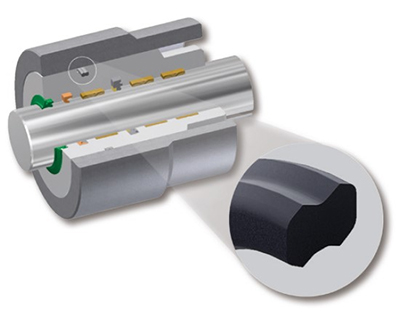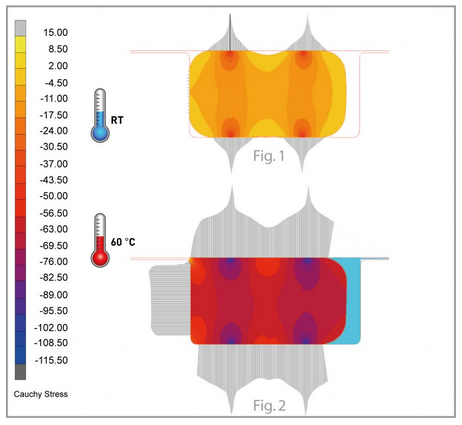O-ring/back-up ring combinations have long been considered the industry standard for static applications at high pressures. In field use, however, they may show weaknesses with respect to their installation and operation in the application. Standard O-rings are often prone to twisting, while back-up rings are oftentimes not installed in the proper position or damaged during installation. Furthermore, this sealing combination may exhibit deficits when 
The robust symmetrical seal geometry and use of particularly extrusion-resistant Parker polyurethane compounds not only simplifies installation but also enhances the sealing effect in pulsating pressure conditions. As a result, service life is significantly extended.
Advantages for the User
The HS seal, compared to the conventional O-ring/back-up ring combinations, offers the following advantages:
• Easy installation
• No twisting
• High extrusion resistance of the polyurethane materials
• Extrusion resistance many times higher than that of conventional O-rings
• Longer service life
• Suitable for standard O-ring grooves with back-up rings
Finite Element Analysis Illustrates Reliable Operating at High Pressures
The figures below show the results of finite elements calculations on the HS profile radial seal in two operating conditions, i.e. when installed at room temperature, in pressure-less conditions (Fig. 1), and after pressure loading of 600 bar plus heating to 60 °C (Fig. 2), each time with a reduced extrusion gap. The color scale shows the stress levels in the seal in radial direction whereas the length of the vertical lines in the contact area between the seal and the groove represents the level of the surface pressure or sealing pressure that acts there.
The compression areas of the sealing edge pairs of the HS profile radial seal can be clearly detected in both figures. This compression leads to a distribution of the sealing pressure with two peaks where the pressure amounts to around 20 MPa. In Fig. 2, it is overlapped by the hydrostatic pressure of 600 bar, with the curve essentially remaining unchanged.
The advantages of the HS radial seal result from the serial configuration of the two sealing areas, which doubles the protection against leakage compared to a single seal. In addition, with two sealing areas or sealing edge pairs backing up the seal, exceptional protection against twisting of the seal is achieved, both during installation and in operation at pulsating pressures, for instance in combination with breathing components and coaxiality defects of the groove.
The use of particularly extrusion-resistant materials, especially the P6000 polyurethane compound with 94 Shore A hardness, eliminates the need for back-up rings. This is illustrated in Fig. 2 as here, in the area of the sealing gap on the non-pressurized side, only minor extrusion can be expected even at a pressure of 600 bar and increased temperature. Furthermore, the elimination of back-up rings provides advantages due to simplified installation.
Range of Application
The Ultrathan® seal HS is suitable for radial, static applications at high pressures such as:
• Hydraulic Valves
• Hydraulic Cylinders
• Machine Tools
• Injection-molding machines
• Any static sealing point requiring radial sealing
If you have any questions regard the Parker HS radial seal, or O-Ring/back-up ring combinations, please do not hesitate to contact us. We have an in-house engineering department at the ready to seal your most difficult applications.

